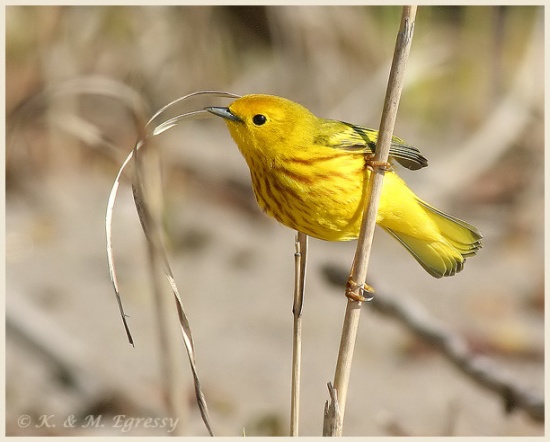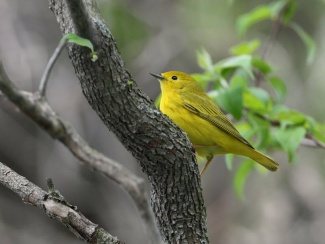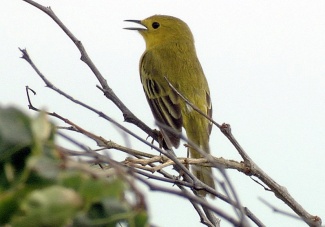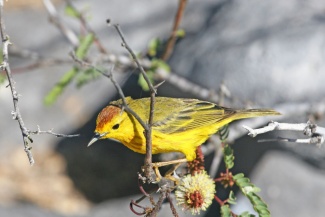KCFoggin-243 (talk | contribs) |
m (→External Links: updated VSearch and GSearch) |
||
| (15 intermediate revisions by 4 users not shown) | |||
| Line 1: | Line 1: | ||
| − | [[Image:Yellow_Warbler.jpg|thumb|550px|right|Male<br />Photo | + | [[Image:Yellow_Warbler.jpg|thumb|550px|right|Male<br />Photo © by {{user|kegressy|K & M Egressy}} <br />Point Pelee, Ontario, [[Canada]], May 2005]] |
;[[:Category:Setophaga|Setophaga]] petechia | ;[[:Category:Setophaga|Setophaga]] petechia | ||
'''Includes: Mangrove Warbler, Golden Warbler''' | '''Includes: Mangrove Warbler, Golden Warbler''' | ||
==Identification== | ==Identification== | ||
| + | [[Image:609-07292fg Female Yellow Warbler.jpg|thumb|325px|right|Female<br />Photo © by {{user|bobsofpa|bobsofpa}}<br />Magee Marsh, [[Ohio]], USA, 10 May 2009]] | ||
12·5 cm (5 in); A widespread New World warbler, with great geographical variation.<br /> | 12·5 cm (5 in); A widespread New World warbler, with great geographical variation.<br /> | ||
*Length 12.5-13 cm, weight 7.4-16 g | *Length 12.5-13 cm, weight 7.4-16 g | ||
| Line 14: | Line 15: | ||
*Rusty streaks on breast and flanks | *Rusty streaks on breast and flanks | ||
*In the tropical parts of its breeding range this bird (especially the male) may have a chestnut head or crown patch. | *In the tropical parts of its breeding range this bird (especially the male) may have a chestnut head or crown patch. | ||
| − | + | ||
'''Female''' | '''Female''' | ||
*Plain yellow | *Plain yellow | ||
| Line 20: | Line 21: | ||
*Notice yellow tail spots on undertail (white in most species where present) | *Notice yellow tail spots on undertail (white in most species where present) | ||
Some have pale gray wash to plumage (southwestern US) | Some have pale gray wash to plumage (southwestern US) | ||
| + | *Can be confused with some [[Common Yellowthroat|Common Yellowthroats]]; distinguish using structure, especially bill shape. (More extensive/contrasting yellow fringing to flight feathers is not necessarily a reliable character.) | ||
| + | |||
==Distribution== | ==Distribution== | ||
| + | [[Image:Dendroica petechia chlora.jpg|thumb|325px|right|Subspecies ''chlora''<br />Photo © by {{user|caribemotion|caribemotion}} <br />Cayos Siete Hermanos, [[Dominican Republic]], 2009]] | ||
Breeds within [[North America]] from [[Alaska]] east across [[Canada]] to [[Newfoundland]] and south to southern [[California]], northern [[Oklahoma]], and northern [[:Category:Georgia (U.S. state)|Georgia]]; local in southern [[Florida]]; these [[Dictionary P-S#S|subspecies]] which belong to the ''S. p. aestiva'' group of subspecies which winters in tropics. Additionally found in a number of largely non-migratory subspecies in the [[Caribbean]] (the ''S. p. petechia'' = "golden warbler" group), and in [[Mexico]], [[Central America]] and northern [[South America]] (the ''S. p. erithachorides'' = "mangrove warbler" group). In total, there are thirty-four subspecies. The three groups mentioned have previously been considered separate species but are now considered one wide-ranging species. | Breeds within [[North America]] from [[Alaska]] east across [[Canada]] to [[Newfoundland]] and south to southern [[California]], northern [[Oklahoma]], and northern [[:Category:Georgia (U.S. state)|Georgia]]; local in southern [[Florida]]; these [[Dictionary P-S#S|subspecies]] which belong to the ''S. p. aestiva'' group of subspecies which winters in tropics. Additionally found in a number of largely non-migratory subspecies in the [[Caribbean]] (the ''S. p. petechia'' = "golden warbler" group), and in [[Mexico]], [[Central America]] and northern [[South America]] (the ''S. p. erithachorides'' = "mangrove warbler" group). In total, there are thirty-four subspecies. The three groups mentioned have previously been considered separate species but are now considered one wide-ranging species. | ||
Accidental (''S''. [''p''.] ''aestiva'') to [[Greenland]] (2 records), [[Iceland]] (1 record), and [[Great Britain]] (3 records). | Accidental (''S''. [''p''.] ''aestiva'') to [[Greenland]] (2 records), [[Iceland]] (1 record), and [[Great Britain]] (3 records). | ||
| − | |||
==Taxonomy== | ==Taxonomy== | ||
| − | + | Sometimes split into two species, American Yellow Warbler (''Setophaga aestiva'') and Mangrove Warbler (''Setophaga petechia'')<sup>[[#References|3]]</sup>. Formerly placed in the genus [[:Category:Dendroica|''Dendroica'']]. | |
| − | |||
| − | Formerly placed in the genus [[:Category:Dendroica|''Dendroica'']]. | ||
====Subspecies==== | ====Subspecies==== | ||
| − | Consists of as many as | + | [[Image:35379notsure7.jpg|thumb|325px|right|Subspecies ''S. p. gundlachi''<br />Photo © by {{user|mrmike|Mike Patterson}}<br />[[Cuba]], 29 January 2007]] |
| − | *'''American Yellow Warbler''' '' | + | Consists of as many as 34 subspecies<sup>[[#References|1]]</sup>: |
| − | **''S. p. rubiginosa'' - | + | *'''American Yellow Warbler''' ''S. p. aestiva'' Group - breeds North America; strongly migratory, wintering interior northern [[South America]] |
| − | + | **''S. p. rubiginosa'' - South [[Alaska]] to western [[British Columbia]]; winters to southern [[Baja California]] and [[Panama]] | |
| − | **''S. p. | + | **''S. p. amnicola'' - [[Alaska]], [[Canada]] and [[Newfoundland]]; winters to northern [[South America]] |
| − | **''S. p. | + | **''S. p. aestiva'' - South-central [[Canada]] and central [[US]]; winters to [[South America]] |
| − | **''S. p. | + | **''S. p. morcomi'' - Southeast [[British Columbia]], western [[US]] and northern [[Baja California]]; winters to northern [[South America]] |
| − | **''S. p. | + | **''S. p. sonorana'' - Southwest [[US]] to northwest [[Mexico]]; winters to western [[Panama]], [[Colombia]] and [[Ecuador]] |
| − | **''S. p. | + | **''S. p. dugesi'' - Central plateau of [[Mexico]] |
| − | * | + | *'''Mangrove Warbler''' ''S. p. erithachorides'' Group - breeds Central America, Caribbean, northern South America; non-migratory |
| − | + | [[Image:Unknown little bird.jpg|thumb|325px|right|Male, subspecies ''S. p. aureola''<br />Photo © by {{user|5larchfield|5larchfield}}<br />Espanola, [[Galapagos]], 5 December 2007]] | |
| − | + | **''S. p. oraria'' - Mangroves of eastern [[Mexico]] (southern Tamaulipas to western Tabasco) | |
| − | [[Image:Unknown little bird.jpg|thumb| | + | **''S. p. bryanti'' - Mangroves of Yucatán Peninsula to [[Belize]] and [[Costa Rica]] |
| − | + | **''S. p. erithachorides'' - Atlantic coast of [[Panama]] and [[Caribbean]] coast of northern [[Colombia]] | |
| − | **''S. p. oraria'' - | + | **''S. p. chrysendeta'' - Northeast [[Colombia]] (Guajira Peninsula) and north-western [[Venezuela]] (Zulia) |
| − | **''S. p. bryanti'' - | + | **''S. p. paraguanae'' - Northwest [[Venezuela]] (Paraguaná Peninsula of Falcón) |
| − | **''S. p. erithachorides'' - | + | **''S. p. cienagae'' - North [[Venezuela]] (coastal Carabobo and Aragua) and offshore islands |
| − | **''S. p. chrysendeta'' - | + | **''S. p. castaneiceps'' - Mangroves of coastal southern [[Baja California]] (south of latitude 27°N) |
| − | **''S. p. paraguanae'' - | + | **''S. p. rhizophorae'' - Mangroves of northwest [[Mexico]] (Sonora to Nayarit); winters to Oaxaca |
| − | **''S. p. cienagae'' - | + | **''S. p. xanthotera'' - Pacific coast of western [[Guatemala]] to [[Costa Rica]] |
| − | **''S. p. castaneiceps'' - | + | **''S. p. aequatorialis'' - Pearl Islands and adjacent mainland [[Panama]] |
| − | **''S. p. rhizophorae'' - | + | **''S. p. peruviana'' - Extreme southwest [[Colombia]] (Nariño) to western [[Ecuador]] and northern [[Peru]] (Lima) |
| − | **''S. p. | + | *'''Galapagos Yellow Warbler''' ''Setophaga p. aureola'' Group - Galapagos and Cocos Islands; non-migratory |
| − | **''S. p. | + | **''S. p. aureola'' - Cocos Islands (off [[Costa Rica]]) and [[Galapagos Islands]] |
| − | **''S. p. | + | *'''Golden Yellow Warbler''' ''Setophaga p. petichia'' Group - Caribbean Islands; non-migratory |
| − | * | + | [[Image:Yellow Warbler Juvie 72 2468.jpg|thumb|325px|right|Subspecies ''S. p. aureola''<br />Photo © by {{user|STEFFRO1|Robert Steffens}}<br />[[Galapagos Islands]], August 2015]] |
| − | **''S. p. | + | **''S. p. rufivertex'' - Cozumel Island (off Quintana Roo) |
| − | * | + | **''S. p. armouri'' - Isla Providéncia (western Caribbean Sea) |
| − | + | **''S. p. flavida'' - Isla San Andrés (western Caribbean Sea) | |
| − | [[Image:Yellow Warbler Juvie 72 2468.jpg|thumb| | + | **''S. p. eoa'' - [[Jamaica]] and [[Cayman Islands]] |
| − | + | **''S. p. gundlachi'' - Lower [[Florida]] Keys, [[Cuba]], Isle of Pines and [[Bahamas]] | |
| − | + | **''S. p. albicollis'' - [[Hispaniola]], Gonâve and adjacent islands | |
| − | **''S. p. rufivertex'' - | + | **''S. p. cruciana - [[Puerto Rico]] and [[Virgin Islands]] |
| − | **''S. p. armouri'' - | + | **''S. p. bartholemica'' - [[Montserrat]] and northern [[Lesser Antilles]] |
| − | **''S. p. flavida'' - | + | **''S. p. melanoptera'' - [[Guadeloupe]], [[Dominica]] and central Lesser Antilles |
| − | **''S. p. eoa'' - | + | **''S. p. ruficapilla - [[Martinique]] (Lesser Antilles) |
| − | **''S. p. gundlachi'' - | + | **''S. p. babad'' - [[St. Lucia]] (Lesser Antilles) |
| − | + | **''S. p. petechia'' - [[Barbados]] (Lesser Antilles) | |
| − | **''S. p. albicollis'' - | + | **''S. p. alsiosa'' - [[Grenadines]] (Lesser Antilles) |
| − | **''S. p. | + | **''S. p. rufopileata'' - [[Aruba]], [[Curaçao]], [[Bonaire]], and adjacent islands |
| − | + | **''S. p. obscura'' - Islas Los Roques (off northern [[Venezuela]]) | |
| − | **''S. p. bartholemica'' - | + | **''S. p. aurifrons'' - Coastal north-central Venezuela, Islas La Tortuga, Tortuguillas and Piritu |
| − | **''S. p. melanoptera'' - | ||
| − | **''S. p. babad'' - | ||
| − | **''S. p. petechia'' - | ||
| − | **''S. p. alsiosa'' - | ||
| − | **''S. p. rufopileata'' - | ||
| − | **''S. p. obscura'' - | ||
| − | **''S. p. aurifrons'' - | ||
==Habitat== | ==Habitat== | ||
| Line 85: | Line 79: | ||
The Mangrove Warbler is sometimes further subdivided into Mangrove Warbler (''S. p. erithachorides'' group) mainly in mangroves, and Golden Warbler (''S. p. petechia'' group), which exhibits geographical variation in its habitat choice, ranging from mangroves to coastal scrub to highland moist forest depending on the island. | The Mangrove Warbler is sometimes further subdivided into Mangrove Warbler (''S. p. erithachorides'' group) mainly in mangroves, and Golden Warbler (''S. p. petechia'' group), which exhibits geographical variation in its habitat choice, ranging from mangroves to coastal scrub to highland moist forest depending on the island. | ||
==Behaviour== | ==Behaviour== | ||
| − | |||
====Breeding==== | ====Breeding==== | ||
| − | + | [[Image:Mangrove Warbler-9 - Copy.jpg|thumb|325px|right|Mangrove Warbler, subspecies ''castaneiceps'' <br />Photo © {{user|Thomas+P+Brown|Thomas P Brown}}<br />La Paz, [[Mexico]], 24 March 2016]] | |
| − | + | Four or five pale blue eggs, thickly spotted with brown, in a well-made cup of bark, plant fibers, and down, placed in an upright fork in a small sapling. The main species to be paratisized by cowbirds ([[Brown-headed Cowbird]] in temperate North America and [[Shiny Cowbird]] in tropical areas). If the female finds an alien egg in the nest she may cover it and lay another clutch. This strategy is not known in the Far Western part of their range. | |
| − | The main species to be paratisized by cowbirds ([[Brown-headed Cowbird]] in temperate North America and [[Shiny Cowbird]] in tropical areas). If the female finds an alien egg in the nest she | + | ====Diet==== |
| + | Feeds mainly on insects and other arthropods; also some berries. Forages by gleaning, hovering and flycatching. | ||
====Vocalisation==== | ====Vocalisation==== | ||
'''Song:''' Cheery, melodic ''sweet-sweet-sweet, sweeter-than-sweet''; there is some geographical variation<br /> | '''Song:''' Cheery, melodic ''sweet-sweet-sweet, sweeter-than-sweet''; there is some geographical variation<br /> | ||
'''Call:''' A sharp ''chip'' | '''Call:''' A sharp ''chip'' | ||
| + | ====Movements==== | ||
| + | Resident in the South. In the north generally short-distance to long-distance migrants. Vagrant to Britain, Ireland, Iceland, the Azores, Salvages Is and France . | ||
| + | |||
==References== | ==References== | ||
| − | # Dunn, J., & Garrett, K. (1997). ''A Field Guide to Warblers of North America''. Boston: Houghton Mifflin Company. ISBN 9780395783214 | + | [[Image:PhoenixAA.jpg|thumb|325px|right|Photo © by {{user|1micalngelo|1micalngelo}}<br />Story Mill, [[Montana]], 20 June 2020]] |
| − | #{{Ref- | + | #{{Ref-Clements6thAug19}}#Dunn, J., & Garrett, K. (1997). ''A Field Guide to Warblers of North America''. Boston: Houghton Mifflin Company. ISBN 9780395783214 |
| + | #{{Ref-GillDonskerRasmussen20V10.1}}#Lowther, P. E., C. Celada, N. K. Klein, C. C. Rimmer, and D. A. Spector (2020). Yellow Warbler (Setophaga petechia), version 1.0. In Birds of the World (A. F. Poole and F. B. Gill, Editors). Cornell Lab of Ornithology, Ithaca, NY, USA. https://doi.org/10.2173/bow.yelwar.01 | ||
{{ref}} | {{ref}} | ||
| + | |||
==External Links== | ==External Links== | ||
| − | {{GSearch|Warbler | + | {{GSearch|"Setophaga petechia" {{!}} "Yellow Warbler" {{!}} "Mangrove Warbler" {{!}} "Golden Warbler"}} |
| + | <br /> | ||
| + | {{VSearch|"Setophaga petechia" {{!}} "Yellow Warbler" {{!}} "Mangrove Warbler" {{!}} "Golden Warbler"}} | ||
| + | {{GS-checked}}1 | ||
| + | <br /> | ||
<br /> | <br /> | ||
| − | + | ||
[[Category:Birds]][[Category:Setophaga]] [[Category:Videos]] | [[Category:Birds]][[Category:Setophaga]] [[Category:Videos]] | ||
Latest revision as of 19:04, 26 April 2023
- Setophaga petechia
Includes: Mangrove Warbler, Golden Warbler
Identification
12·5 cm (5 in); A widespread New World warbler, with great geographical variation.
- Length 12.5-13 cm, weight 7.4-16 g
- Thin, pointed bill
- Mostly yellow plumage
- Upperparts greenish-yellow
- Yellowish legs
- Plain yellow face with yellow eye ring
Male
- Golden yellow
- Rusty streaks on breast and flanks
- In the tropical parts of its breeding range this bird (especially the male) may have a chestnut head or crown patch.
Female
- Plain yellow
- Streaks on breast absent or barely present
- Notice yellow tail spots on undertail (white in most species where present)
Some have pale gray wash to plumage (southwestern US)
- Can be confused with some Common Yellowthroats; distinguish using structure, especially bill shape. (More extensive/contrasting yellow fringing to flight feathers is not necessarily a reliable character.)
Distribution
Breeds within North America from Alaska east across Canada to Newfoundland and south to southern California, northern Oklahoma, and northern Georgia; local in southern Florida; these subspecies which belong to the S. p. aestiva group of subspecies which winters in tropics. Additionally found in a number of largely non-migratory subspecies in the Caribbean (the S. p. petechia = "golden warbler" group), and in Mexico, Central America and northern South America (the S. p. erithachorides = "mangrove warbler" group). In total, there are thirty-four subspecies. The three groups mentioned have previously been considered separate species but are now considered one wide-ranging species.
Accidental (S. [p.] aestiva) to Greenland (2 records), Iceland (1 record), and Great Britain (3 records).
Taxonomy
Sometimes split into two species, American Yellow Warbler (Setophaga aestiva) and Mangrove Warbler (Setophaga petechia)3. Formerly placed in the genus Dendroica.
Subspecies
Consists of as many as 34 subspecies1:
- American Yellow Warbler S. p. aestiva Group - breeds North America; strongly migratory, wintering interior northern South America
- S. p. rubiginosa - South Alaska to western British Columbia; winters to southern Baja California and Panama
- S. p. amnicola - Alaska, Canada and Newfoundland; winters to northern South America
- S. p. aestiva - South-central Canada and central US; winters to South America
- S. p. morcomi - Southeast British Columbia, western US and northern Baja California; winters to northern South America
- S. p. sonorana - Southwest US to northwest Mexico; winters to western Panama, Colombia and Ecuador
- S. p. dugesi - Central plateau of Mexico
- Mangrove Warbler S. p. erithachorides Group - breeds Central America, Caribbean, northern South America; non-migratory
- S. p. oraria - Mangroves of eastern Mexico (southern Tamaulipas to western Tabasco)
- S. p. bryanti - Mangroves of Yucatán Peninsula to Belize and Costa Rica
- S. p. erithachorides - Atlantic coast of Panama and Caribbean coast of northern Colombia
- S. p. chrysendeta - Northeast Colombia (Guajira Peninsula) and north-western Venezuela (Zulia)
- S. p. paraguanae - Northwest Venezuela (Paraguaná Peninsula of Falcón)
- S. p. cienagae - North Venezuela (coastal Carabobo and Aragua) and offshore islands
- S. p. castaneiceps - Mangroves of coastal southern Baja California (south of latitude 27°N)
- S. p. rhizophorae - Mangroves of northwest Mexico (Sonora to Nayarit); winters to Oaxaca
- S. p. xanthotera - Pacific coast of western Guatemala to Costa Rica
- S. p. aequatorialis - Pearl Islands and adjacent mainland Panama
- S. p. peruviana - Extreme southwest Colombia (Nariño) to western Ecuador and northern Peru (Lima)
- Galapagos Yellow Warbler Setophaga p. aureola Group - Galapagos and Cocos Islands; non-migratory
- S. p. aureola - Cocos Islands (off Costa Rica) and Galapagos Islands
- Golden Yellow Warbler Setophaga p. petichia Group - Caribbean Islands; non-migratory
- S. p. rufivertex - Cozumel Island (off Quintana Roo)
- S. p. armouri - Isla Providéncia (western Caribbean Sea)
- S. p. flavida - Isla San Andrés (western Caribbean Sea)
- S. p. eoa - Jamaica and Cayman Islands
- S. p. gundlachi - Lower Florida Keys, Cuba, Isle of Pines and Bahamas
- S. p. albicollis - Hispaniola, Gonâve and adjacent islands
- S. p. cruciana - Puerto Rico and Virgin Islands
- S. p. bartholemica - Montserrat and northern Lesser Antilles
- S. p. melanoptera - Guadeloupe, Dominica and central Lesser Antilles
- S. p. ruficapilla - Martinique (Lesser Antilles)
- S. p. babad - St. Lucia (Lesser Antilles)
- S. p. petechia - Barbados (Lesser Antilles)
- S. p. alsiosa - Grenadines (Lesser Antilles)
- S. p. rufopileata - Aruba, Curaçao, Bonaire, and adjacent islands
- S. p. obscura - Islas Los Roques (off northern Venezuela)
- S. p. aurifrons - Coastal north-central Venezuela, Islas La Tortuga, Tortuguillas and Piritu
Habitat
In the US, inhabits moist thickets, especially along streams and in swampy areas, gardens, overgrown pastures, and woodland edges, it is more limited to riparian habitat in the west than the east.
The Mangrove Warbler is sometimes further subdivided into Mangrove Warbler (S. p. erithachorides group) mainly in mangroves, and Golden Warbler (S. p. petechia group), which exhibits geographical variation in its habitat choice, ranging from mangroves to coastal scrub to highland moist forest depending on the island.
Behaviour
Breeding
Four or five pale blue eggs, thickly spotted with brown, in a well-made cup of bark, plant fibers, and down, placed in an upright fork in a small sapling. The main species to be paratisized by cowbirds (Brown-headed Cowbird in temperate North America and Shiny Cowbird in tropical areas). If the female finds an alien egg in the nest she may cover it and lay another clutch. This strategy is not known in the Far Western part of their range.
Diet
Feeds mainly on insects and other arthropods; also some berries. Forages by gleaning, hovering and flycatching.
Vocalisation
Song: Cheery, melodic sweet-sweet-sweet, sweeter-than-sweet; there is some geographical variation
Call: A sharp chip
Movements
Resident in the South. In the north generally short-distance to long-distance migrants. Vagrant to Britain, Ireland, Iceland, the Azores, Salvages Is and France .
References
- Clements, J. F., T. S. Schulenberg, M. J. Iliff, S. M. Billerman, T. A. Fredericks, B. L. Sullivan, and C. L. Wood. 2019. The eBird/Clements Checklist of Birds of the World: v2019. Downloaded from http://www.birds.cornell.edu/clementschecklist/download/
- Dunn, J., & Garrett, K. (1997). A Field Guide to Warblers of North America. Boston: Houghton Mifflin Company. ISBN 9780395783214
- Gill F, D Donsker & P Rasmussen (Eds). 2020. IOC World Bird List (v10.1). doi : 10.14344/IOC.ML.10.1. Available at http://www.worldbirdnames.org/
- Lowther, P. E., C. Celada, N. K. Klein, C. C. Rimmer, and D. A. Spector (2020). Yellow Warbler (Setophaga petechia), version 1.0. In Birds of the World (A. F. Poole and F. B. Gill, Editors). Cornell Lab of Ornithology, Ithaca, NY, USA. https://doi.org/10.2173/bow.yelwar.01
Recommended Citation
- BirdForum Opus contributors. (2024) Yellow Warbler. In: BirdForum, the forum for wild birds and birding. Retrieved 27 April 2024 from https://www.birdforum.net/opus/Yellow_Warbler
External Links
GSearch checked for 2020 platform.1











